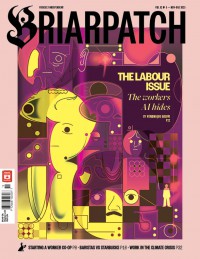Delaying delivery
midwives’ labour lost in Saskatchewan
by Jenn Ruddy
August 2005
Heather Wood will never forget the day when she and a small group of midwifery supporters were granted a meeting with former NDP Health Minister Louise Simard in the early 1990s.
“I remember the excitement, the ‘pinch-me-I-can’t-believe-it’ feeling,” Wood said recently at a Prairie Women’s Health Centre of Excellence forum. “We pitched the need for midwifery, we shared our passion for choice in childbirth, we asked the minister to help us move this agenda forward—and she agreed.”
In 1994, Simard appointed a Midwifery Advisory Committee to assess the need for midwifery in Saskatchewan. After studying the issue for two years, the Committee found there was a need for midwifery in the province and submitted 26 recommendations to the government in April 1996. Among the recommendations was that home birth be an option for low-risk women, that legislation be passed, and that midwifery be publicly funded.
Although the NDP government passed legislation on May 5, 1999, The Midwifery Act has yet to be proclaimed. Perhaps more importantly, the legislation that was drafted failed to fund midwifery services. Consequently, the number of practicing midwives in Saskatchewan plummeted. Disillusioned, several midwives left the province for other jurisdictions, where the profession was both legalized and funded. To date, only four midwives are currently practicing in the province.
“It is utterly unrealistic to imagine that midwifery can thrive without funding,” says Wood, a former Saskatchewan midwife currently practicing in Ontario. “Have you ever heard the Minister of Health suggest that physicians should provide their medical services free of charge? Or that they should seek payment directly from their patients?”
The disappointment that spread throughout the community of midwives in 1999 led to a further disappearance of midwifery from the political agenda. In the past couple of years, however, there has been a renewed sense of enthusiasm and a rejuvenated campaign calling on the NDP government to draft new legislation for a midwifery system that is accessible to all women, regardless of their ability to pay.
Most recently, delegates at an NDP council meeting in June unanimously passed a resolution reaffirming party support for midwifery, and further called on the government to commit to funding a midwifery demonstration project in the Throne Speech of the fall 2005 Legislative session.
“While the Saskatchewan government continues to ponderously review the midwife ‘alternative’,” says Wood, “huge changes have occurred everywhere else in Canada.” Saskatchewan is the only Western Canadian province that has failed to legalize midwifery. Ontario, British Columbia, Quebec, Manitoba, Alberta, Nunavut and the Northwest Territories have all legalized and funded the profession, with the exception of Alberta where midwifery consumers must pay for the service.
According to Wood, there has always been a misperception in Saskatchewan that midwifery is an “alternative” desired only by a small number of vocal women. Today, however, one only has to look at other Canadian provinces where midwifery has been legalized for the past decade to see that consumer demand far outstrips the supply. Moreover, recent studies reveal that the midwifery model of care is safer and healthier for low-risk women and their newborns, and that midwife-attended births are the most cost-effective approach to delivering babies.
As Wood says, “The research is in. Now it’s time for the government of Saskatchewan to organize itself and commit to legalized, funded, and integrated midwifery.”
Everybody’s Doing It
When Heather Wood returned to Saskatchewan to take part in a rally at the Legislature on May 5, 2005, International Day of the Midwife, she brought with her the results of a comprehensive, 10-year review of midwifery that was conducted by the Ontario government. The study found that midwife-attended births have resulted in reduced rates of cesarean sections for low-risk women (12.7 percent versus 19 percent with physicians), fewer forcep deliveries (5.4 percent versus 14.4 percent), fewer episiotomies (7.2 percent versus 16.6 percent), higher rates of breast feeding continuing to six weeks (90.7 percent versus 71.5 percent), and shorter hospital stays for mothers and their newborns.
In addition, the Ontario Health Ministry also found that midwife-attended hospital births save the health care system $800 per birth and that midwife-attended home births further save the health care system $1,800 per delivery.
When Ontario Health Minister George Smitherman announced a $7 million increase in funding last year to support an additional 55 midwives, he said: “Midwifery is a living example of the health principles we are aspiring to. What better way to invest our precious health care dollars than in support of the midwives.” Eager to curb health care spending, Smitherman also said that midwifery makes financial sense.
In Alberta, where midwifery is legalized but not funded, Health Minister Iris Evans announced in May that she will look at funding midwifery services. A study conducted by University of Alberta professor Bev O’Brien found that midwifery saves the health care system between $700 and $1,100 per birth and is healthier for children.
“You can see why most provincial governments intend to expand their midwifery programs,” Wood says. “These numbers prove what the rest of the world knows: midwives are key to satisfying birth experiences and optimal outcomes.”
When Push Comes To Cut
In 2004, the Canadian Institute of Health Information (CIHI) stated in its report, “Giving Birth in Canada,” that more than one in five Canadian babies are being delivered by cesarean-section—an all-time high. Shocking research further reveals that in 2002, only one of 523 hospitals in Canada qualified as “baby-friendly” according to WHO-UNICEF criteria.
Another study conducted by CIHI concluded that the number of family doctors delivering babies is dropping at “an alarming rate.” In Saskatchewan, 40 percent of family physicians are currently delivering babies and that number is expected to drop.
“Midwives are not planning on taking jobs away from anybody who wants them,” Wood said. “In fact the reverse is happening. General practitioners and family physicians are freely and rapidly giving up obstetrics for a host of reasons. Midwives are there, or should be there, to step into what is their specialty—normal birth.”
Unfortunately, however, the number of obstetricians attending to low-risk women in Canada is increasing, which is not only more costly but unsafe. According to Wood, obstetricians are more likely to use unnecessary technological intervention since they are trained specialists.
“Why is Saskatchewan paying specialist obstetricians to attend women at low risk?” Wood says. “That’s like asking an ear, nose and throat specialist to see a woman because she has a simple ear infection. Where is the cost saving? Where is the benefit to women?”
Legislation Overdue
The fact is, here in Saskatchewan, and elsewhere, a growing number of women are turning to a natural holistic approach to childbirth in a time when unnecessary medical intervention is rampant. It has been nine years since the Midwifery Advisory Committee determined there is a need for midwifery in Saskatchewan, yet midwives continue to go without regulation or funding. In 2004, the government released the Action Plan for Saskatchewan Women, which included commitments from various departments pertaining to the health and social status of women in the province. This document, however, failed to include any indication of a commitment to the midwifery model of care.
Nearly every province in Canada that has a legalized midwifery system is expanding its midwifery program. In Manitoba, the NDP government is creating an Aboriginal Midwifery Education Program to provide culturally and medically appropriate maternity care to low-risk women in isolated communities. Dennis White Bird, Grand Chief of the Assembly of Manitoba Chiefs, said the program will be an opportunity to restore a traditional part of the Aboriginal culture.
“In Saskatchewan, women have one choice for childbirth: come to the hospital to deliver your babies into the hands of a physician,” says Wood. “For rural and northern women, their choice is to leave their communities and await their labours alone in another larger centre.”
When Wood was an apprentice midwife in Saskatchewan, she practiced midwifery in an unregulated, unfunded, and sometimes hostile environment, much like the one that still exists here today. Wood has left the province and is now a full-time midwife in Hamilton, Ontario, where she is paid per course of care and valued as a primary care provider. Today, Canada has close to 600 practicing midwives, many of whom take part in policy decisions at hospitals across the country, have the same rights and privileges as physicians, and are considered invaluable caregivers.
“I can practice midwifery openly now,” says Wood. “The nurses and doctors we work alongside know my skills and my competencies. They know the model of midwifery. It feels really good to celebrate that I’m a midwife, to say with confidence, ‘I’m a midwife.’”
Jenn Ruddy will be starting graduate work in the fall at the University of Regina. She has’ been awarded a Social Sciences and Humanities Research Council (SSHRC) grant to examine Women in Saskatchewan Politics.
Readers like you keep Briarpatch alive and thriving. Subscribe today to support fiercely independent journalism.



